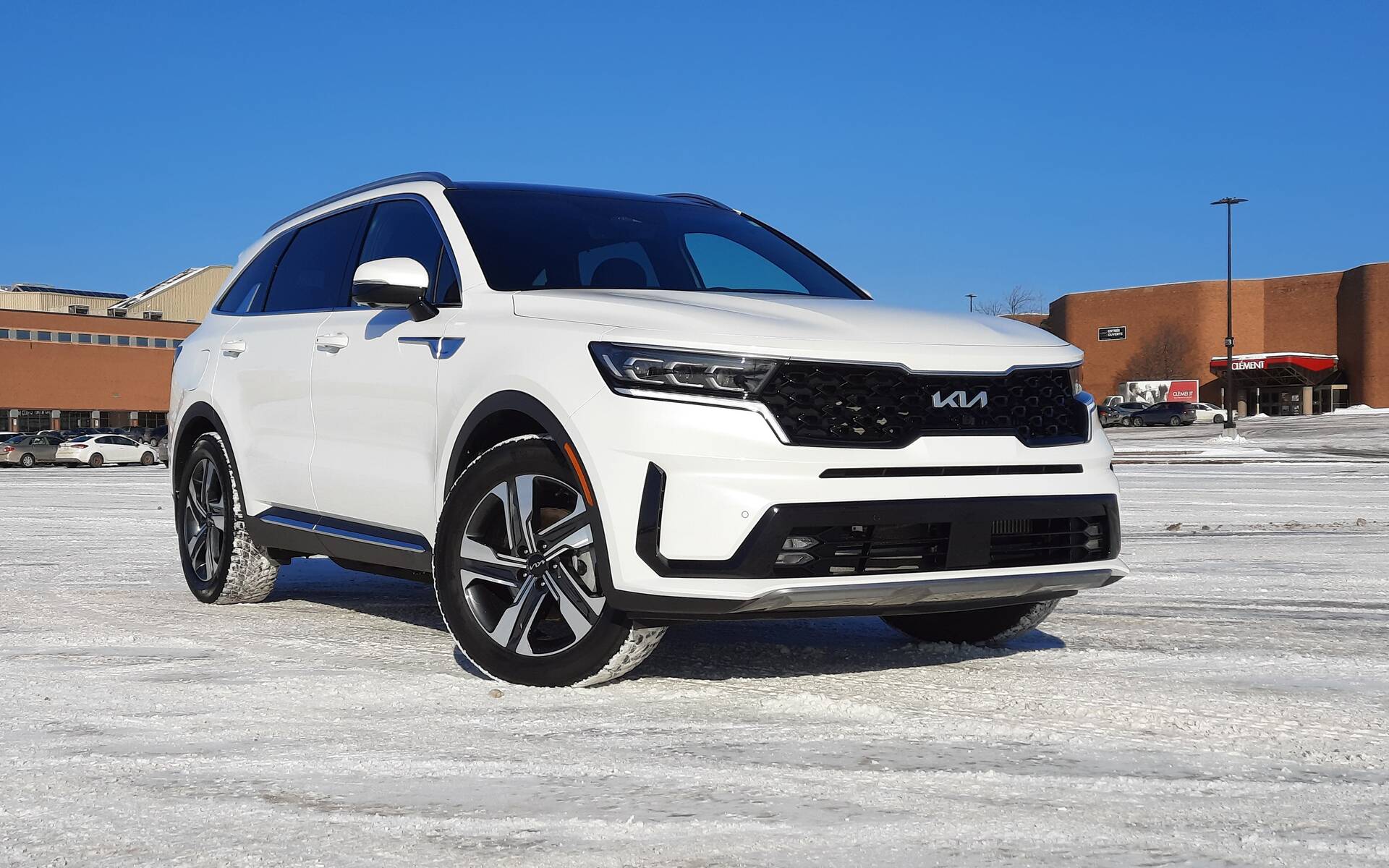2022 Kia Sorento PHEV: Nice Family SUV, Fussy PHEV Tech

| Strong points |
|
|---|---|
| Weak points |
|
After so many years with so few hybrid or electric SUVs on the market, Canadians now have some pretty interesting selection, with even more attractive models to come later in 2022.
At Kia, the Sorento Hybrid and Sorento PHEV recently joined the lineup alongside the three variants of the Niro. The next-generation Sportage will do the same thing for the 2023 model, and that’s great. However, as we found out during our winter test drive of a 2022 Kia Sorento PHEV, the Korean automaker still has work to do in the powertrain department. And plug-in or not, customers have some compromises to make.
- Also: 2022 Kia Sorento PHEV Starts at Under $45K, Has Decent Range
- Also: 2021 Kia Sorento: More Attractive, Yet Less Capable
Aesthetically, the latest Sorento is clearly more assertive and sharper-looking than its predecessor, which kind of resembled a minivan from certain angles. The combination of the headlights and grille gives the vehicle definite attitude. Unsurprisingly, there is little visual distinction between gas-powered Sorentos and their electrified counterparts.

The base Hybrid LX is the only one that rides on 17-inch wheels (all the others have 19-inch alloys) and lacks roof rails. At the other end, the PHEV EX+ and SX (like our tester) separate themselves with full LED lighting units and a huge panoramic roof.
Pleasant Family Time
The interior could almost pass for a luxury SUV when it comes to fit and finish or even gadgets. Check out the 10.25-inch centre touchscreen combined with a 12.3-inch digital instrument panel and head-up display. Kia’s infotainment system is slick, but the various touch-sensitive controls surrounding the screen require a bit too much attention while driving. As for styling, the available two-tone steering wheel and ambient lighting really jazz up the cabin, but some of the brushed metallic inserts on the dashboard and door panels are just too gaudy, similar to the new Carnival minivan.

The Kia Sorento nicely fulfills its family SUV duties. The seats are comfortable for long trips and there’s adequate space all around. Our tester had second-row captain’s chairs providing easy access to the third row, which isn’t as cramped as in some other SUVs (think Mitsubishi Outlander). It’s best suited for children, of course, but adults can occasionally ride in the back, too. On the flip side, the trunk can fit a mere 357 litres of cargo, forcing you to drop the rear seatbacks more often than you normally should.
When it comes to safety, Kia has everybody covered with numerous advanced safety and driver assistance features on most trim levels, although it would be nice if the blind spot monitor wasn’t exclusive to the Sorento PHEV SX. Same thing for collision avoidance assist in reverse and the surround view system. Is it too much to ask for? With a price tag exceeding $50,000, maybe not.

Hybrid or PHEV?
Kia saw what Ford was doing with the Escape and did the opposite: the Sorento Hybrid is FWD-only, while the Sorento PHEV has AWD. The latter proved solid and confident in the snow as well as on icy surfaces during our test drive, including a number of inclines, which should please Canadian drivers.
Similar to the Hyundai Santa Fe Hybrid and Santa Fe PHEV, which rely on an AWD setup exclusively, the gasoline engine isn’t shared with other Sorento models. We’re talking about a small, turbocharged 1.6-litre unit—the same one you can find in the K5, Seltos and upcoming Sportage. It’s a curious move by Kia, especially when you hear the engine vociferate under hard acceleration.

Torque is 258 pound-feet in both cases, but the Sorento PHEV (261 horsepower) is more potent than the Sorento Hybrid (227 horsepower) in order to offset its 300-400 pounds of excess weight, most of it coming from the 13.8kWh high-voltage battery. Sprints in EV mode are generally smooth and effortless, but when the vehicle reverts to hybrid mode things get more complicated and less pleasant. It’s like the two power sources are fighting each other, and the six-speed automatic transmission is not helping. There is a lot of room for improvement here.
As for efficiency, the Sorento PHEV can theoretically go 51 kilometres without burning any fuel, but obviously not that long in winter. And you need to keep the heating system turned off, something we were rarely able to do given the pretty cold temperatures we had to face. Also, the combustion engine is quick to step in even for moderate acceleration. When the battery runs empty, the Sorento PHEV requires more gas than the regular hybrid variant (6.9 L/100 km versus 6.6 L/100 km). On our watch, it averaged just over 8 L/100 km.

Verdict
Need to tow a trailer? The two electrified options are no better than the base gas-powered Sorento, all of them being rated at 2,000 pounds. You must select the turbocharged 2.5-litre engine to get a towing capacity of up to 3,500 pounds.
The 2022 Kia Sorento PHEV starts at $44,995 and is eligible to EV incentives including $2,500 from the federal government. It’s a sensible purchase if you do a lot of short commutes around town and keep the vehicle plugged in anytime you’re not using it, otherwise we’d recommend the Sorento Hybrid instead (starting at $36,695). As for alternatives, we’re huge fans of the Toyota RAV4 Prime’s proven technology, but delivery times are ridiculously long. The new 2023 Outlander PHEV is another strong contender with the promise of 60+ kilometres of EV range.











